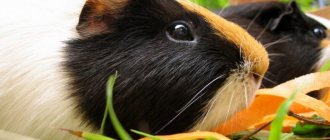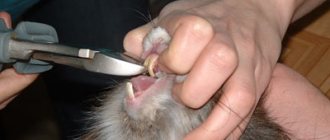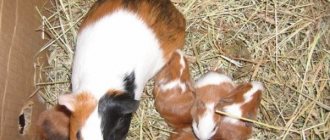- home
- Nutrition
19.03.2018
Scientific livestock breeders produce an abundance of food of plant origin. Hamsters eat potatoes, buckwheat, wheat and even corn. In their burrows, these small rodents are capable of storing food weighing up to 80 kg for the winter. When a small furry creature becomes a member of the family, the new owners have a lot of questions about feeding. Today we’ll talk about whether it’s possible to give hamsters potatoes.
Root vegetables (potatoes, beets, carrots)
Some of them are necessary for the animal every day, others only occasionally. It is also important in what form the rodent receives this or that vegetable. The basic principle is the same as in human nutrition: the less heat treatment a product is subjected to, the more useful substances are preserved in it.
Potato
Veterinarians clearly agree that the vegetable is not recommended for a hamster due to its high starch content. In small quantities, you can occasionally pamper your pet with them - it is acceptable to offer him raw or boiled potatoes, but not fried ones.
Only young potatoes (not green) without pesticides and nitrates are useful for the animal.
Beet
This vegetable is not recommended, but it is occasionally given fresh or boiled to Syrian hamsters. The cube should be no larger than a button, and they start with even smaller sizes in order to track the reaction of the gastrointestinal tract. If tolerance is normal, the portion is increased.
Keep in mind that there are three types of beets - fodder, table and sugar; hamsters are given the second option. The first contains practically no useful substances for the rodent, and the third can lead to diabetes mellitus, especially in Djungarians.
Carrot
It is not only possible, but must be given to the hamster; it is an essential ingredient in the daily diet. A mug 1.5 cm thick is enough for one approach - no more is needed, otherwise the rodent will start making supplies that will quickly spoil.
The best option is to treat your hamster with raw carrots; sometimes it is permissible to diversify the menu with boiled carrots. In addition to vitamins A, C, K, it is rich in dietary fiber, which is beneficial for digestion, and potassium for the heart muscle.
It is recommended to pre-soak all store-bought vegetables in water, this helps remove nitrates and other chemicals from them. Hamsters are sensitive to them, and due to their small size they can be poisoned by even a small portion of vegetables that have absorbed harmful substances.
Sometimes you can put 1 tablespoon of carrot tops in the animal’s bowl - it contains 5 times more vitamins than the root vegetable. But not from a store-bought vegetable - its above-ground parts are often treated with pesticides against pests, which is fatal to the rodent. If it is not possible to treat your pet to greens from your dacha, it is better to buy parsley, celery or lettuce at the supermarket - they are safer for your pet.
Radish
Recommended in small portions 1-2 times a week. Give preference to country vegetables or vegetables grown in your own beds. They contain folic acid, which is especially important for pregnant females; they effectively cleanse the liver and normalize the flow of bile. Pectin cleanses the body of toxins, and its low calorie content makes radishes a dietary product.
Turnip
The root vegetable is useful in all respects, especially for Syrians prone to arthritis - turnips contain substances that protect joints from inflammation. Helps with osteoporosis, serves as a source of potassium and calcium for bones.
Potatoes in the diet of Djungarian hamsters
Djungarian dwarf hamsters, to the chagrin of their owners, often suffer from obesity and a related disease - diabetes. To keep your tiny pet healthy and happy, preventive measures should be taken. Following a special diet will protect the dwarf and prolong its life.
Due to the fact that the starch contained in potato tubers causes weight gain and raises blood sugar levels, it is better not to offer potatoes to Djungarians.
Cucumbers and tomatoes
Both vegetables are beneficial for hamsters, but there are nuances to their introduction into the diet.
Cucumber
Allowed fresh 1 time per day, daily intake – up to 50 grams. Store-bought cucumbers are peeled and pre-soaked. Give it to young animals up to 2 months with caution, observing the reaction of the still immature gastrointestinal tract.
Young cucumbers are 90% water, helping to cope with excess weight and normalize digestion. The minerals in them strengthen bones, teeth, B vitamins – the nervous system, but most importantly, they remove toxins and heavy metal salts.
Tomatoes and cherry tomatoes
Tomatoes are useful for digestion, respiratory function, cleansing blood vessels and capillaries. They protect the hamster from cancer due to the content of lycopene and antioxidants. Strengthen nerve fibers and have a beneficial effect on the hematopoietic organs. They contain a lot of iodine for the thyroid gland and magnesium for the heart. They are given fresh without peel 1-2 times a week; preference is given to tomatoes from your own plot, grown without the use of chemicals.
In Syrian hamsters, tomatoes can provoke or aggravate arthritis; it is better not to give these rodents tomatoes.
The benefits of fruit for rodents
The composition contains a large amount of vitamins and microelements.
Magnesium and potassium have a positive effect on the animal’s musculoskeletal system, its cardiovascular, nervous and urinary systems.
Iron increases hemoglobin content, helps relieve fatigue, hunger and restore strength.
Phosphorus is necessary to strengthen the animal’s bones and teeth.
The main thing is to use the product in moderation. Digestion is normalized, the blood vessels in the rodent’s body will become flexible and elastic.
Morning time is most favorable for eating fruits
When choosing a banana for your pet, pay attention to the peel. It should be yellow and strong
Rotten, blackened fruits should not be given.
You can start feeding your pet these fruits in the second month of life.
Cabbage and its varieties
Syrian hamsters are prohibited from introducing it into their diet - the structural features of the gastrointestinal tract do not allow them to digest cabbage fibers.
Djungarian and Roborovsky hamsters can be offered the following types during the season (from August to November) 2-3 times a week, 50 grams each:
- colored (fresh, boiled);
- Beijing (fresh);
- broccoli (fresh).
You can read more about the formation of the diet of Djungarians and Syrians in separate articles.
It is not recommended for hamsters to include white cabbage in the menu - it causes fermentation in the intestines. And red-headed varieties are strictly prohibited - death is possible due to bloating.
Recommended Products
In the wild, hamsters eat mainly grain crops; this nuance can be taken into account when composing the diet of the dzhungarik.
In addition to grain crops, in the wild hamsters can also eat animal food, sometimes turning into a predator, eating carrion or killing smaller animals. At home, you should take this factor into account when choosing food.
Special dry food
Diet at home must include special grain feed. There are a huge variety of them on our market, so you can offer the dzhungarik a choice and follow his preferences
In addition to their composition, they differ strikingly in their quality, which is also worth paying attention to. The case when a home protests and flatly refuses a certain brand is far from uncommon.
Also, you should not feed your Djungarian hamster with grain mixtures intended for other animals.
Protein food
A couple of times a week you should feed the jungarik with protein foods, such as cottage cheese or a piece of boiled chicken; a boiled chicken or quail egg, or low-fat boiled fish are perfect. All of the above products must be prepared without spices and seasonings that are harmful to the small body.
Let's look at the list of products that you can still feed the homa:
| Cereals: | Nuts: | Seeds: | Greenery: |
|
|
|
|
Before feeding homa with parsley, dill and other herbs, rinse and dry it thoroughly. Thanks to this simple procedure, moisture that may contain harmful substances will disappear. Remember that parsley has a laxative effect and should not be given if the homa is pregnant.
Other vegetables
Don't forget to supplement your pet's diet with other healthy vegetables. They will not be among the basic ones, but if consumed 1-2 times a week they will bring tangible benefits to his body.
Eggplant
Recommended for fresh consumption, it is usually alternated with other vegetables, offering the hamster no more than 50 grams at a time. When purchasing, avoid overripe fruits - eggplants are useful because they restore the water-mineral balance in the animal’s body; unripe and stale fruits are not suitable for this.
Pumpkin
Contains a lot of fiber, beta-carotene, good for the eyes, phosphorus, iron, potassium. Useful as a treat even for overweight animals and diabetics. But, unlike carrots, it is not suitable as a daily food.
Pumpkin should diversify the diet, and not become its basis; it is useful in fresh, stewed, boiled form. Be sure to have no peel - it is cut off in a thick layer.
When baking, pumpkin should not be seasoned with oil, spices or salt. This puts a lot of strain on the liver of a rodent, which in nature does not eat such things.
Zucchini
It is one of the dietary products recommended fresh without peel. For sick, weakened, young animals (up to 6 weeks), it is useful to puree it with a blender.
Zucchini cannot be the basis of the daily diet - veterinarians advise alternating it with other juicy vegetables: cucumbers, eggplants, pumpkin.
Zucchini and pumpkin seeds deserve special attention. This healthy treat will help the rodent cope with parasites, as it has anthelmintic properties.
Precautionary measures
Adding a new product to the diet of dzhungarika requires some precautions:
- When offering your pet nuts, consider its age, breed and size. The smaller the animal, the smaller the portion should be.
- Do not serve peanuts in the shell. Putting food in the cheek pouches can cause injury to your hamster. Peanut shells can cut your baby's esophagus and stomach.
- Do not overfeed your pet. Peanuts and hazelnuts have a high fat content, which disrupts the functioning of the animal’s digestive system. By overfeeding your animal with high-calorie foods, you harm its health.
- The animal must eat natural products. Peanuts should not be given after heat treatment.
- The rodent's diet should be varied. Offer him a different product each time.
- Do not give sweet, salty or spicy foods. Salted peanuts are harmful to the kidneys and liver.
Nuts are a tasty and nutritious treat. They have properties that are beneficial to the health of the hamster. However, it should be remembered that not all fruits can be included in your pet’s diet. Follow the feeding rules, and your pet will be healthy, cheerful and active.
Daily diet for a furry pet
Angoras are more picky about the quality of food than dwarfs or other dwarf rodents. Their daily diet should include not only cereal grains (oats, corn, millet) but also vitamins. Pet stores sell special food for pets, which contains a complex of useful substances. However, your pet can also get vitamins from fruits and vegetables, which it is advisable to include in his daily food.
Angora hamsters readily eat carrots, pumpkin, apples, lettuce and dandelion leaves, dill, and parsley. Rodents will also get the necessary substances from sunflower seeds and nuts. To replenish protein reserves, your pet can be fed with boiled liver and boiled chicken meat. The main thing is that all the food in the hamster's feeder is fresh.
You should feed your pet no more than twice a day. It is advisable to replenish the supply of drinking water in his home approximately once every two days.
From time to time it is necessary to conduct an audit of the fluffy's house and check what he has brought into his pantry. There should not be too much perishable food in a hamster’s diet, otherwise the consequences may be disappointing. A long-haired rodent can not only stain its coat with vegetables or fruits that have begun to rot, but also become seriously ill.
To avoid unpleasant consequences, it is necessary to exclude potatoes, cabbage leaves, garlic, onions, and citrus fruits from the Angora hamster’s diet. It is advisable to avoid various exotic fruits and fruits with seeds.
Since Angora hamsters are prone to obesity, their feeding should be done under the supervision of the owner. In the house the animal should have many accessories for active body movements.
When are potatoes ready to be pulled? | Home Guides
Posted by Tammie Painter Updated December 15, 2021
If you have a sunny spot in the garden with loose, fertile soil, you can grow your own potatoes (Solanum tuberosum). Seed potatoes can be purchased from your local potato patch or purchased at garden centers. Within two weeks of the last average frost in your area, plant seed potatoes in the ground. As the plants grow, mound soil around the foliage to support the plant and encourage tuber formation. If you keep the soil moist and hilly, your potatoes will grow well. To get the maximum yield and the most flavorful potatoes, you need to harvest them at the right time.
New potatoes
New potatoes are young tubers from the potato plant. These small potatoes have softer skins than mature potatoes and should be eaten soon after harvest as they do not store well. Typically, most potato varieties take about 10 weeks after planting to produce tubers large enough to eat. If you lose track of how many weeks have passed since planting, just watch your potatoes; when it flowers, it is ready for harvest. Instead of digging up the entire plant, carefully push back the soil and remove only a few potatoes from each plant. The plants can then continue to grow, producing a fall crop of mature potatoes.
Ripe potatoes
Mature potatoes are harvested in the fall or early winter, depending on your plants and the weather. Wait until all of the plant's foliage is dry and withered before harvesting mature potatoes. After the foliage has died, dig up potatoes from one or two plants and rub the skin of the potatoes with your fingers. The skins of potatoes that are ready to be harvested are not easily wiped off. If the skin of the test potatoes still comes off easily, wait a few more days and try a couple more potatoes.
Harvesting Rules
Once your potato foliage has died, remove it from the potato bed as soon as possible. Potato foliage can carry diseases that are transmitted to the tubers by contact with the leaves. Additionally, harvest potatoes in dry weather within a few days to reduce the chance of leaf disease spreading. Dig up the potatoes and handle them carefully so as not to damage the skin or damage the tuber. If the skin does become damaged, set these potatoes aside and eat them within a few days of harvest.
Potato storage
If stored properly, mature potatoes can last for several months. The first step in proper storage is to clean the potatoes by removing any dirt with a soft brush or cloth. Do not wash the potatoes. Then leave the potatoes in a dark place between 45 and 60 degrees Fahrenheit for two weeks. After two weeks, if any potatoes look wilted or soft, discard them. Store leftover potatoes in a dark place that does not exceed 35 to 40 degrees Fahrenheit. If you keep apples, keep them away from the potatoes, otherwise the potatoes may sprout.
.
Which beets are best to give?
The root vegetable retains its beneficial properties even with heat treatment, and can also be stored for a long time, which is very good in winter, when choosing quality fruits and vegetables can be difficult. But what is best for hamsters? Let's figure it out.
Raw beets
This vegetable can definitely be fed to an animal. It is worth choosing a small root vegetable, not too soft and without rotten places on it. Ideally, the vegetable grew in your garden.
If this is not possible, then buy the product from trusted people who grow with natural fertilizers without any chemicals. Remember that after eating something of poor quality once, the hamster may die.
Boiled beets
Hamsters can also use it in this form. But it is worth considering the peculiarities of preparation.
- Before serving, wash the vegetable well.
- Cook for a short time so that it does not lose its beneficial properties.
- You cannot add salt to the water or add spices and spices. It seems to us that it will taste better this way, but it will only make things worse for the baby.
- The peel must be cut off.
- The slice should not exceed 1 cm in size.
- You should not give this treat too often. Several times a week will be enough.
Source
Chicken or quail
Chicken yolk contains vitamins A, D, and E, polyunsaturated fatty acids. Vitamin D promotes the absorption of calcium, which strengthens bones. There is as much of it in eggs as there is in fish oil. The yolk contains iron.
Quail eggs contain five times more potassium and iron, 2.5 times more vitamins B1 and B2, vitamin A, niacin, phosphorus, copper, cobalt, and other amino acids.
If you have the opportunity to buy quail, because they are more expensive than chicken, you need to choose them. Quail eggs contain much more useful substances than chicken eggs. They have high nutritional value, quickly restore immunity after illness, strengthen blood vessels, and do not cause allergic reactions.
Although the ratio of beneficial nutrients in quail and chicken eggs is different, remember - they are all useful and valuable foods for a hamster.
What to buy to please your pet
Pet stores offer a wide range of treats for hamsters. But you shouldn’t take the first product you come across. Carefully study the composition of the product before purchasing. Unscrupulous manufacturers add ingredients that are harmful and even dangerous to animals. The treat should not contain: salt, sugar, fats, artificial additives (flavors, dyes, taste enhancers). Consider your pet's breed when choosing treats. For example, some foods allowed for Syrians are not suitable for Djungarians.
If the product contains prohibited components, the hamster may be poisoned. The functioning of the digestive tract will also be disrupted, which will negatively affect the condition of the animal.
Hamsters may refuse treats. Monitor your pet's reaction and remember what the rodent ate with pleasure and what it preferred to leave untouched. Taste preferences depend on the character and breed of the hamster.
It is recommended to choose treats consisting of nuts, sunflower seeds, dried vegetables and fruits, and banana chips. Such products are a favorite treat for hamsters.
The stores offer:
- Various mixtures with berries, fruits and grains. Additionally, the mixtures include vitamins and healthy additives.
- Hamster sticks consisting of grains, fruits, vegetables and herbs. The range of sticks is quite diverse.
- Tartlets made from unleavened dough with various fillings.
- Treats in hemp are not only healthy and tasty food for rodents, but also entertainment.
- Yummy in the shape of a labyrinth or a house. The hamster will be able to have a snack and play at the same time.
Feed groups
The quality of pork products directly depends on the quality of the food on which the pig is fed. All feeds are divided into three groups according to their effect on meat quality.
- The first group of food products allows us to obtain high quality meat products.
- The second group has less useful qualities and is suitable for obtaining varieties of meat of average quality.
- The third group includes poor food, which directly affects the quality of meat. However, it can be safely fed to young animals up to 60 kg in weight.
For premium meats
Feeds of this group allow you to obtain pork of the highest quality and dense, grainy lard. To fatten premium quality meat pigs, the diet must include green feed and mixed feed. These include:
- Juicy vegetables and root crops. Potatoes, carrots, pumpkin, sugar beets.
- Green food. Shchiritsa, nettle, alfalfa, sainfoin, clover.
- Cereals. Barley, millet, peas, rye.
- Roughage. Hay flour from legumes (alfalfa, clover, sainfoin).
- Fermented milk products and meat waste.
For medium grades of meat
This group of feeds includes lower quality food products. They can make up up to half of the total feed mass, but it is advisable not to exceed this amount. With constant feeding of pigs with these products, meat and lard gradually lose their taste. Such foods can be beneficial (for example, corn gives animals a lot of energy, but contains almost no protein), but it is advisable to introduce their diet together with the first group. These include:
- corn;
- buckwheat;
- wheat and rye bran.
How to give correctly
As mentioned above, potatoes are safe for almost all breeds of hamsters, but this rule only applies if a few rules are followed. Only in this case can an optimal balance be achieved between starches, fats, vitamins and minerals, and this will ensure not only safety for health, but also help extend the lifespan and youth of the rodent.
To do this, you just need to adhere to the following requirements:
- raw vegetables are given only in small pieces and always without peels and sprouts;
- preference should be given to boiled potatoes, they should contain at least 60% of the total volume of the vegetable;
- give the tuber no more than once a week, the maximum portion for an adult animal should not exceed 30 g;
- Before giving your hamster raw slices of tubers, it is recommended to soak them in clean cold water for 1–2 hours, changing the liquid periodically. This will remove excess starch from the pulp, as well as accumulated nitrates and other toxins.
Important! It is forbidden to cook and feed green potatoes raw; they contain the dangerous toxin solanine, which even in small doses can lead to the death of a hamster.
How to give correctly
As mentioned above, potatoes are safe for almost all breeds of hamsters, but this rule only applies if a few rules are followed. Only in this case can an optimal balance be achieved between starches, fats, vitamins and minerals, and this will ensure not only safety for health, but also help extend the lifespan and youth of the rodent.
To do this, you just need to adhere to the following requirements:
- raw vegetables are given only in small pieces and always without peels and sprouts;
- preference should be given to boiled potatoes, they should contain at least 60% of the total volume of the vegetable;
- give the tuber no more than once a week, the maximum portion for an adult animal should not exceed 30 g;
- Before giving your hamster raw slices of tubers, it is recommended to soak them in clean cold water for 1–2 hours, changing the liquid periodically. This will remove excess starch from the pulp, as well as accumulated nitrates and other toxins.
Important! It is forbidden to cook and feed green potatoes raw; they contain the dangerous toxin solanine, which even in small doses can lead to the death of a hamster.











